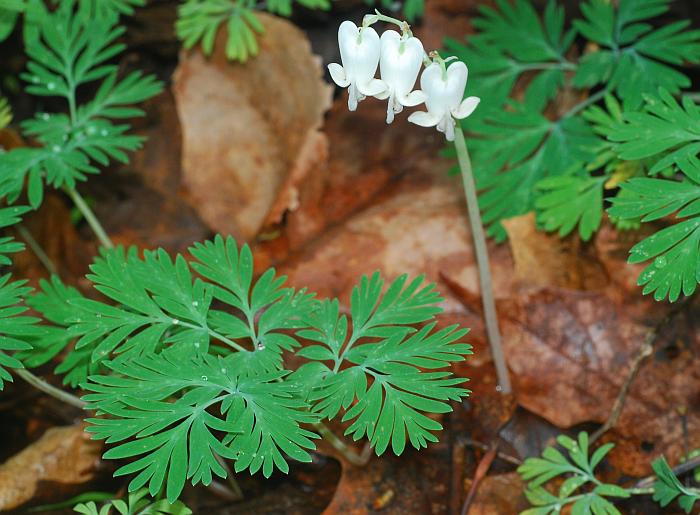Dicentra canadensis (Goldie) Walp.
Squirrel Corn

Native
CC = 9
CW = 5
MOC = 14
© SRTurner
Dicentra canadensis (Goldie) Walp.Squirrel Corn | |
 |
Native CC = 9 CW = 5 MOC = 14 |
© SRTurner |
|
Family - Fumariaceae Habit - Perennial forb with tuberlike bulblets. Stems - Absent.
Leaves - All basal, long-petiolate, the petiole 8-24 cm long. Leaf blades usually 4 times compound and lobed, 4.5-9.0 cm long, ovate to broadly triangular in outline, the ultimate segments linear to narrowly oblong-elliptic or narrowly oblanceolate, rounded but often with a minute, sharply pointed projection at the tip, dark green to bluish green above, the undersurface moderately to strongly glaucous.
Inflorescences - Racemes 10-35 cm long, long-stalked and relatively densely 3-15-flowered.
Flowers - Bilaterally symmetrical in 2 perpendicular longitudinal planes, the stalks 2-14 mm long, pendent at flowering and fruiting, with a pair of small bractlets positioned noticeably below the flower. Sepals 2-4 mm long, triangular to ovate, attached basally, rounded to more or less truncate base, the margins entire, membranous and white. Corollas white, sometimes pinkish-tinged, with a yellow to orangish yellow tip. Inner petals linear or nearly so toward the base, expanded above the midpoint with a broadly winged margin and a well-developed, entire to slightly undulate crest, rounded at the concave tip. Outer petals 12-20 mm long, the concave apical portion 3-5 mm long, abruptly spreading, yellow to greenish yellow (occasionally pinkish-tinged), the remaining portion white, the short spurs 0.5-2.0 mm long, rounded (pouchlike), more or less parallel to slightly incurved. Style persistent, relatively slender, the stigma 4-lobed, the lobes appearing as horns and/or wings.
Fruits - Capsules, dehiscent (sometimes tardily so), 5-15 mm long, narrowly more or less ellipsoid, straight, the surface often slightly swollen over the seeds, otherwise smooth, 3- to numerous-seeded. Seeds 1.5-2.5 mm long, somewhat flattened, kidney-shaped in outline, rounded along the rim, the surface smooth or nearly so, black, shiny, the elaiosome an irregular, somewhat conic, white mass attached in the notch.
Flowering - March - May. Habitat - Bottomland forests and ravines, bases of north-facing bluffs. Origin - Native to the U.S. Lookalikes - D. cucullaria. Other info. - In Missouri this species is far less common than its close sibling, Dicentra cucullaria (Dutchman's breeches), though the situation is reversed in areas to our northwest. In Missouri it has been recorded from 14 counties, mostly on the eastern side of the state. Missouri represents the southwestern corner of the plant's distribution, which extends into New England and Canada.
Photographs taken at Washington State Park, Washington County, MO, 4-11-2011, 4-15-2014, and 5-3-2014 (SRTurner). |